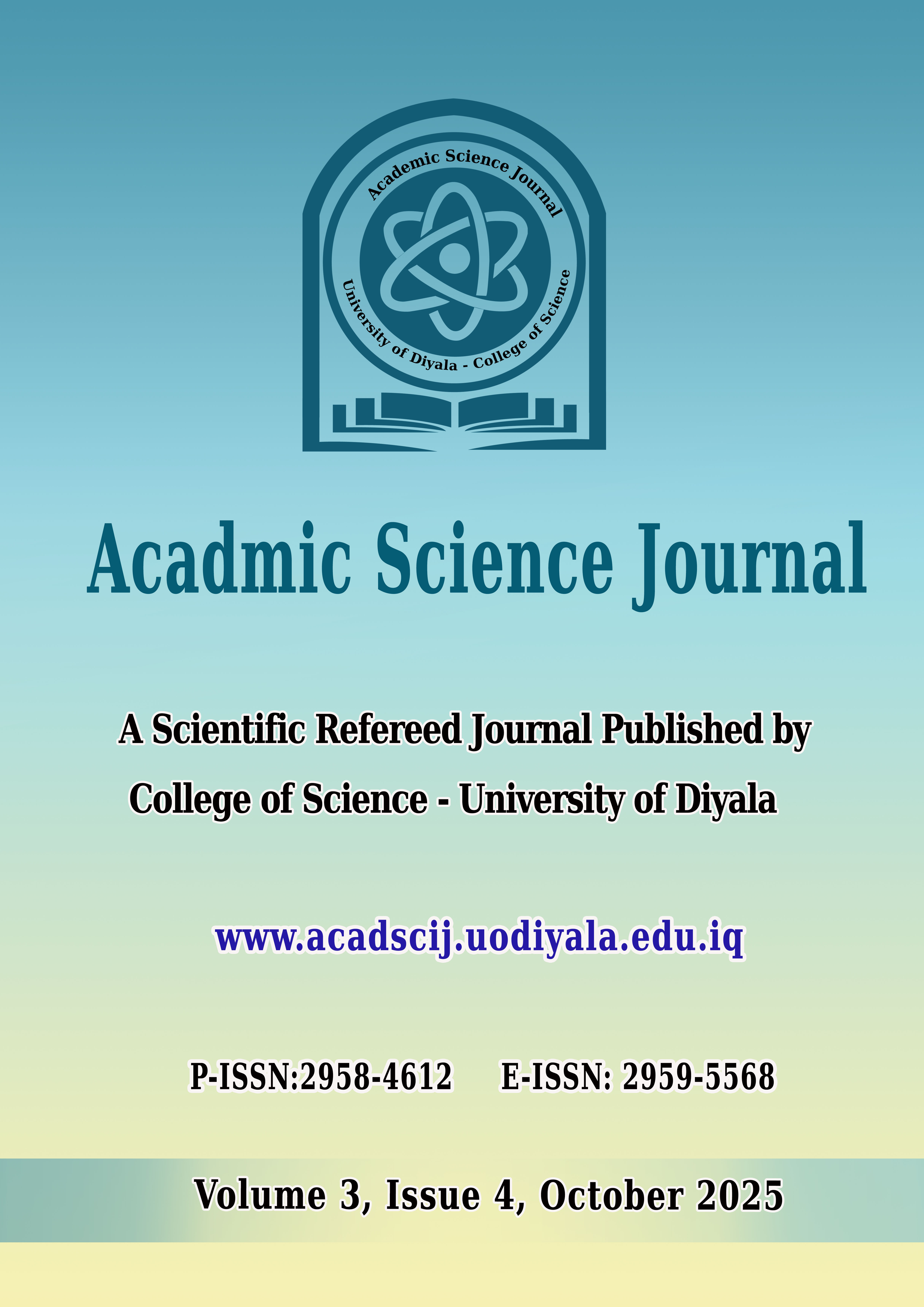Synthesis of LiCo0.25Ni0.75O2 via Citric-urea Combustion Route as a Cathode for Lithium-ion Batteries
DOI:
https://doi.org/10.24237/ASJ.03.04.874DAbstract
The LiCo0.25Ni0.75O2 compound was prepared by a citric-urea combustion rout in this study. the study presented a comprehensive analysis of the decomposition process and formation of metal oxides in LiCo0.25Ni0.75O2 sample using Thermogravimetric Analysis (TGA), Crystalline structure and surface morphology of the prepared powder are investigated by (XRD) and (FESEM). The results of the XRD patterns for LiCo0.25Ni0.75O2 sample show high intensity peaks that indicated a good crystallinity with the Calcination Temperature, while the morphology results show indicates that sample was in the nanostructure dimensions. Electrochemical measurements showed The capacity of the charging and discharging were of 177.6 mAhg-1 and 166.9 mAhg-1 delivered by the LiCo0.25Ni0.75O2 cathode. Likewise, a columbic efficiency of 93.9% was obtained for the cathode.
Downloads
References
[1] B. Dunn, H. Kamath, J. M. Tarascon, Electrical energy storage for the grid: a battery of choices, Science, 334(6058), 928-935(2011), DOI(https://doi.org/10.1126/science.1212741)
[2] M. Z. Abdullah, H. M. Hasan, M. H. Al-Timimi, W. H. Albanda, M. K. Alhussainy, Preparation and characterization of carbon doped lithium iron phosphate composite as cathode for rechargable battery, Journal of Ovonic Research, 15(3), (2019)
[3] Z. Šimić, D. Topić, G. Knežević, D. Pelin, Battery energy storage technologies overview, International journal of electrical and computer engineering systems, 12(1), 53-65(2021), DOI(https://doi.org/10.32985/ijeces.12.1.6)
[4] J. B. Goodenough, and K. S. Park, The Li-Ion Rechargeable Battery: A Perspective, American Chemical Society, 135(4), 1167-1176(2013), DOI(https://doi.org/10.1021/ja3091438 )
[5] J. Xu, X. Cai, S. Cai, Y. Shao, C. Hu, S. Lu, and S. Ding, High-Energy Lithium-Ion Batteries: Recent Progress and a Promising Future in Applications, Energy &Environmental Materials, 6, 2575-0356(2023), DOI(https://doi.org/10.1002/eem2.12450)
[6] B. Ren, H. Cui, and C. Wang, Self-supported graphene nanosheet-based composites as binder-free electrodes for advanced electrochemical energy conversion and storage, Electrochem Energy Rev, 5(32), (2022), DOI(https://doi.org/10.1007/s41918-022-00138-6)
[7] A. Haider, R. Al-Anbari, G. Kadhim, and Z. Jameel, Synthesis and photocatalytic activity for TiO 2 nanoparticles as air purification, MATEC Web Conf, 162, (2018), DOI(https://doi.org/10.1051/matecconf/201816205006)
[8] M. Z. Abdullah, H. M. Hasan, M. H. Al-Timimi, W. H. Albanda, M. K. Alhussainy, M. Dumitru, Journal of Ovonic Research, 15(3), 199-204(2019)
[9] A. G. Olabi, Q. Abbas, P. A. Shinde, and M. A. Abdelkareem, Rechargeable batteries: technological advancement, challenges, current and emerging applications, Energy, 266, 126408(2023), DOI(https://doi.org/10.1016/j.energy.2022.126408)
[10] M. Akhilash, P. S. Salini, B. John, and T. D. Mercy, A journey through layered cathode materials for lithium ion cells – from lithium cobalt oxide to lithium-rich transition metal oxides, J. Alloys Compd, 869, 159239(2021), DOI(https://doi.org/10.1016/j.jallcom.2021.159239)
[11] S. S. H. Al-Mgrs, M. H. A. Al-Timimi, M. Z. Abdullah, and W. H. Al-Banda, Structural and optical characterizations of synthesized CMC/PVP-SnO2 nano composites, AIP Conference Proceedings, 2475(1), (2023), DOI(https://doi.org/10.1063/5.0102768)
[12] J. H. Adawiya, K. M. Chahrour , A. J. Addie, A. Q. Abdullah, P. R. Jubu, S. I. AL-Saedi, and A. N. Naje, Crystallinity tuning of LCNO/graphene nanocomposite cathode for high-performance lithium-ion batteries, Materials Science and Engineering B, 300, 117116(2024), DOI(https://doi.org/10.1016/j.mseb.2023.117116)
[13] A. J. Haider, R. A. Rsool, M. J. Haider, R. A. Rsool, and A. B. Dheyab, Properties of LiCo0.5Ni0.45Ag0.05O2 thin films for high storage energy capacity by pulsed laser deposition, Energy Rep, 6, 85–94(2020), DOI(https://doi.org/10.1016/j.egyr.2020.08.028)
[14] X. Cui, L. Zhang, Y. Hu, D. Yang, and J. Zou, Optimization of VOSO4@C cathode materials with CNT and GO for lithium-ion batteries, J. Alloys Compd., 914, 165354(2022), DOI(https://doi.org/10.1016/j.jallcom.2022.165354)
[15] M. S. Shalaby, M. O. Alziyadi, H. Gamal, and S. Hamdy, Solid-state lithium-ion battery: the key components enhance the performance and efficiency of anode, cathode, and solid electrolytes, J. Alloys Compd, 969, 172318(2023), DOI(https://doi.org/10.1016/j.jallcom.2023.172318)
[16] M. Z. Abdullah, M. H Al-Timimi, W. H. Albanda, M. Dumitru, A. E. Balan, C. Ceaus, and I. Stamatin, Structural and Electrochemical Properties of P3-Na0. 67Mn0. 3Co0. 7O2 Nanostructures Prepared by Citric-Urea Self-Combustion Route as Cathode for Sodium Ion Battery, Digest Journal of Nanomaterials and Biostructures, 4, 1179-1193(2019)
[17] N. Balasooriya, and P. Bandaranayake, Electrochemical Properties of LiCo0.4Ni0.6O2 and its Performances in Rechargeable Lithium Batteries, Sri Lankan Journal of Physics, 8, (2007), DOI(https://doi.org/10.4038/sljp.v8i0.213)
[18] P. Periasamy, B. R. Babu, R.Thirunakaran, and N.Kalaiselvi, Solid-state synthesis and characterization of LiCoO2 and LiNiyCo1-yO2 solid solutions, Bulletin of Materials Science, 23(5), (2000), DOI(https://doi.org/10.1007/BF02708382)
[19] K. S. Landage, G. K Arbade, P. Khanna, C. J Bhongale, Biological approach to synthesize TiO2 nanoparticles using Staphylococcus aureus for antibacterial and anti-biofilm applications, Journal of Microbiology & Experimentation, 8, 36 - 43(2020), DOI(https://doi.org/10.15406/jmen.2020.08.00283)
[20] S. S. Nisa, M. Rahmawati, C. S. Yudha, H. Nilasary, H. Nursukatmo, H. S. Oktaviano, S. U. Muzayanha, and A. Purwanto, A Fast Approach to Obtain Layered Transition-Metal Cathode, Batteries, Material for Rechargeable Batteries, 8(4), (2022), DOI(https://doi.org/10.3390/batteries8010004)
[21] Y. Chen, G.X. Wang, J. P. Tian, K. Konstantinov, and H. K. Liu, Preparation and properties of spherical LiNi0.75Co0.25O2 as a cathode for lithium-ion batteries, Electrochimica acta, 50, 435-441(2004), DOI(https://doi.org/10.1016/j.electacta.2004.03.053)
[22] T. F. Yi, Z. K. Fang, Y. Xie, Y.R. Zhu, and L.Y. Zang, Synthesis of LiNi0. 5Mn1.5O4 cathode with excellent fast charge-discharge performance for lithium-ion battery, Electrochimica acta, 147, 250-256(2014), DOI(https://doi.org/10.1016/j.electacta.2014.09.119)
[23] D. Li. Luo, G. Fu, C. Zheng, J. Fan, J. Q. Li, and L. Li, A New Spinel‐Layered Li‐Rich Microsphere As A High‐Rate Cathode Material For Li‐Ion Batteries, Advanced energy materials, 4(11), 1400062(2014), DOI(https://doi.org/10.1002/aenm.201400062)
[24] C. Deng, S. Zhang, S. Y. Yang, Y. Gao, B. Wu, L. Ma, B. L. Fu, Q. Wu, and F. L. Liu, Effects of Ti and Mg codoping on the electrochemical performance of Li3V2(PO4)3 cathode material for lithium ion batteries, The Journal of Physical Chemistry C, 115(30), 15048-15056(2011), DOI(https://doi.org/10.1021/jp201686g)
Downloads
Published
Issue
Section
License
Copyright (c) 2025 CC BY 4.0

This work is licensed under a Creative Commons Attribution 4.0 International License.





